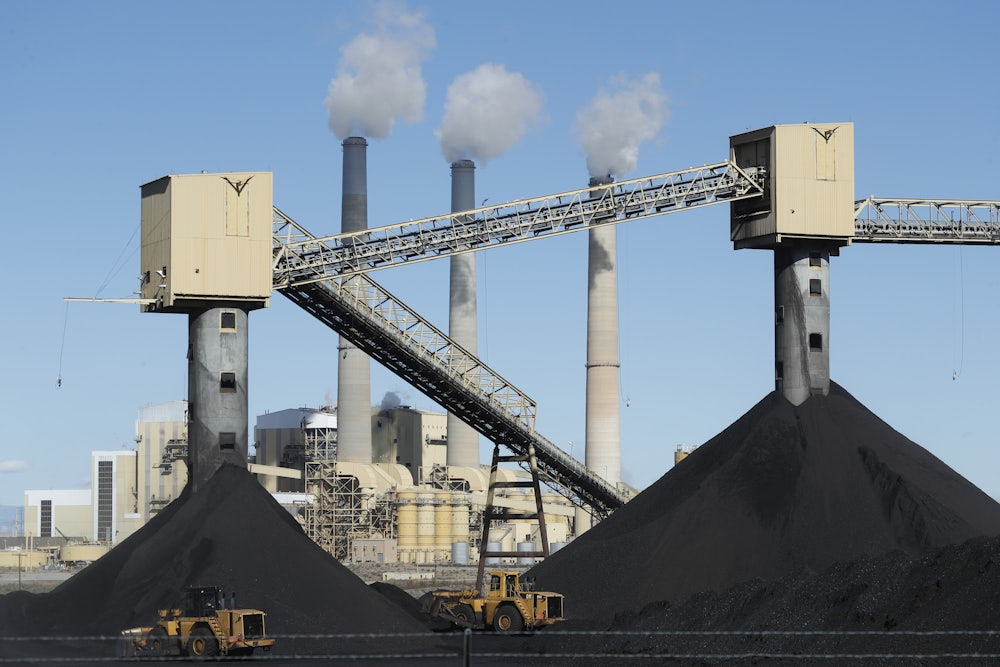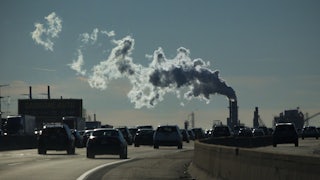Sometime soon, the Environmental Protection Agency will unveil new rules governing power plants’ greenhouse gas emissions. The standards are expected to rely heavily on a controversial emissions-reduction technology known as carbon capture utilization and storage, in which emissions are trapped at their source before entering the atmosphere. The technology has long been touted by the fossil fuel industry and its defenders—such as Senators Kyrsten Sinema and Joe Manchin—but still has a very limited track record. In fact, there isn’t a single commercial power plant in the United States currently using it.
The EPA’s new regulation could see the industry’s more fantastical claims about carbon capture come back to bite it. If the new rules look like early reports suggest they will, they would effectively be calling the bluff of those who have claimed for years that this expensive technology—still unproven at scale—is a unicorn solution that will allow polluters to continue to burn coal, oil, and gas without furthering a planetary catastrophe.
Experts predict the EPA will base its clean-performance standard for power plants on a “best system of emission reduction” that includes carbon capture’s capacity to neutralize emissions. In other words, the new rules won’t mandate that power plants use the technology but will treat it as one of many ways to meet the reductions goal. Some utility companies may instead choose to shut down dirty plants, opting for a cheaper option like wind or solar; gas plants may use hydrogen. “It’s going to be up to the states and the companies to look at their options and choose whether they want to keep that plant online,” the Natural Resources Defense Council’s Lissa Lynch told energy writer David Roberts.
Two people familiar with the rulemaking process told Politico that the proposal “would require power companies to capture most of their carbon emissions rather than letting it enter the atmosphere” (if, that is, they’re not slashing emissions by other means). “No commercial power plants in the United States use carbon-capturing technology now, but the agency views it as ready to be used widely,” the sources said. According to the Global CCS Institute, there are just two commercial power plants on earth that are currently using carbon capture and storage, in Canada and China. The 30 carbon capture sites that were operational last year, mostly at industrial locations, captured about 0.1 percent of global emissions. Eleven more facilities were under construction.
The Supreme Court’s decision last summer in West Virginia v. EPA is surely front of mind for regulators crafting these rules. In that ruling, the court’s right-wing majority found that the agency’s Clean Power Plan—proposed by the Obama administration in 2015—had overstepped the mandate Congress gave it via a specific section of the Clean Air Act. Rather than regulating emissions per power plant, the Obama-era regulation had set out rules for the power sector generally. The new Biden rules reportedly would require changes of individual plants. It’s thanks to the Supreme Court decision, as well, that the standards are unlikely to mandate that companies reduce emissions through a specific means.
The Inflation Reduction Act also hangs over this process. The law’s incentives for wind and solar have made it possible to deploy renewables more quickly and make deeper cuts in power sector emissions, turning them into an attractive alternative to coal and gas. Expanded tax credits for carbon capture and storage should make it more feasible for plants to reduce their emissions more aggressively, now the technology is more heavily subsidized and thus more appealing. In comments supporting new rules to the EPA, green groups have argued that these shifts mean the agency can require more ambitious reductions. NRDC modeling found that the IRA makes it possible for the EPA to mandate a 77 percent reduction in power sector emissions by 2030, relative to 2005 levels. The group adds that carbon capture devices are “similar to sulfur dioxide scrubbers and other pollution controls on which the EPA has been basing standards for decades.”
Evergreen Action similarly suggests that new standards “should be set at the most stringent levels achievable via adequately demonstrated technology applicable inside the fenceline.” Since carbon capture is a “cost-reasonable and adequately demonstrated technology,” the group wrote in a letter to the EPA, “reductions of 90% are achievable for both coal-fired and gas-fired power plants.”
The implicit reasoning here seems to be that—given the still-high cost of retrofitting existing coal plants—many power providers will simply opt to take another, cheaper route. “The cost of adding CCS or hydrogen is likely to make many plants unviable because of the comparative affordability of renewables and storage,” said Holly Jean Buck, a sociologist at the University of Buffalo who has done extensive research on emissions-reductions technologies. “That isn’t to say that there will be no CCS at all anywhere, just that it won’t be the cheapest option in many places.”
Climate groups that support the new rules thus are in the position of explicitly vouching for questionable, hotly debated technologies that some say are just an excuse for fossil fuel producers to extend the lives of polluting plants. But in the U.S. power sector, at least, those technologies might now be the basis for accomplishing the opposite: By taking carbon capture seriously, the rules would force its boosters to put their money where their mouths are.
Still, any such outcome is a long way off. The EPA’s proposal may not come out until next month, after which point there will be a round of public comments before a final rule is issued. Depending on when it comes out and what happens in the 2024 elections, the standard could also be subject to the Congressional Review Act—that is, Republicans could nullify it if they win control of Congress and the White House. However careful the EPA’s lawyers have been, Republican attorneys general are still likely to mount a legal challenge akin to the one they brought against Obama’s Clean Power Plan. If they do—and if the rules are written along the lines reported—fossil fuel companies might have to admit that their climate savior isn’t such a messiah, after all.






